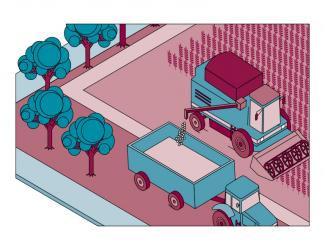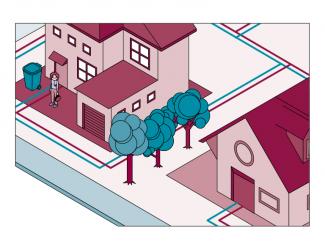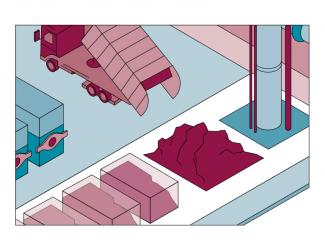
The shift towards a circular economy
(This article was originally published in L'Édition n°16)
Scientists at Université Paris- Saclay have been developing sustainable business models and efficient new circular processes to support mass production industries with their ecological transition.
With countries like France committing to carbon neutrality by 2050, people are following suit. Sustainable development is gradually taking root in people’s minds and eco-friendly initiatives are on the increase. However, faced with the climate emergency and its consequences for the planet and its inhabitants, the global economy must be reassessed. This involves, among other things, increased restraint, an end to the overexploitation of the planet’s limited resources and a reduction in carbon footprint. At the heart of this approach is the development of a circular economy for a sustainable transition which reconciles ecology with economic development.
Production from waste
Currently, the economy is largely based on a linear model. Natural resources are extracted to manufacture products (and their packaging) which are then sold, distributed, used and discarded at the end of their life. It is an energyconsuming model which generates waste and pollutants. The circular economy proposes reusing waste locally by transforming it into raw materials and reducing the environmental impact of consumption by placing material and energy flows in a continuous loop.
Over the past few years, several sustainable initiatives have been introduced on a large scale, such as the recovery of energy from waste incineration and the recycling of plastics, metals and glass. Nevertheless, these processes still need to be improved as most of the value of incinerated waste goes up in smoke and the quality of recycled plastic is not the same as the original. Actions which support the circular economy are also possible for ordinary citizens. This can be done by favouring a more responsible approach to consumption based on short supply chains and composting, or by simply extending the life of consumer products by exchanging services or goods, repairing used products and adopting good sorting habits for recyclable products.
As the saying goes, “together we are stronger”. In order to be effective, the circular economy requires investment and commitment – especially from those at the forefront, i.e. mass production industries. In France, the construction sector produces about 30% of the country’s greenhouse gas, the food industry is responsible for about 30% of household waste (mainly uneaten food) and the transport industry recycles very little of its commercial production. In contrast, responsible companies who make products from recycled materials, facilitate disassembly, reduce repair costs and recycle their own waste, greatly reduce their carbon footprint.
A worthwhile undertaking at a local level
The circular economy has many advantages. “However, it is only worthwhile when it is implemented at a local level,” explains André Torre, a researcher at the Science for Action and Development: Activities, Products, Regions Laboratory (SADAPT – Univ. Paris-Saclay, INRAE, AgroParisTech) and a specialist in regional sustainable development. If the concept of regional is broad, the reality is much less so. It is a matter of encouraging the local circulation of goods and services by bringing producers closer to consumers. “Carrying out recycling abroad or consuming products from foreign organic farming isn’t worthwhile as they involve a lot of time spent in transit and therefore result in greenhouse gas emissions,” points out the researcher. Much more than mere geographical proximity, a closer relationship between different local stakeholders is crucial. “Neighbouring businesses should have compatible operations in order to recycle their waste and reuse their energy locally.”
Businesses are not the only ones who can benefit from focusing on a circular economy. By opening up a new market in the recycling sector, a circular economy helps to create jobs across the whole region. So, why is it not more widespread? The main obstacle at the moment is purely financial. With the exception of a few sectors that have already made the transition, such as food with short supply chains, biogas plants or heat networks, most companies find it difficult to change their production processes. One of the reasons for this is that they find it difficult to evaluate and value the benefits. Given this situation, government investment is needed to support businesses in their transition by offering financial incentives and simple, rapid assessment methods for sustainable investments.
Strengthening industrial circularity – a closer look at urban agriculture
Several scientists at Université Paris-Saclay are working to support companies in their efforts to become more sustainable. They are developing simplified analytical tools to help companies optimise the circularity of their industrial processes and reduce their carbon footprint. Several sustainable strategies which are feasible on an industrial scale are currently being considered in partnership with various industrial sectors.
Christine Aubry and Erica Dorr, who are urban agriculture specialists at the SADAPT laboratory, have developed strategies in collaboration with a mushroom farm located in the French department of Yvelines (78) to limit the environmental impact of their activity. “Urban agriculture has been developing in France over the last ten years. It is an opportunity to implement the circular economy as it reuses urban waste locally,” explain both researchers. “The local aspect of the operation means that journeys are reduced to a minimum and producers and consumers can talk to each other more easily.”
The mushroom farm is already well developed and generates a double circular economy in that, on the one hand, coffee grounds are reused as a growing medium for Pleurotus ostreatus (or oyster mushrooms) and, on the other, the mushroom compost is reused by farmers in the Île-de-France region to create fertiliser. Although this economy is already strong, the farmers would like to continue to reduce their emissions, which currently amount to 3kg of CO2 per kilogram of mushrooms. By modelling different scenarios, the researchers have identified two strategies which will reduce their environmental impact by 45%. They involve reducing the pasteurisation time of the coffee grounds and improving sanitary practices to maximise the yield.
Apart from reusing organic urban waste, these analysis models also contribute to the development of alternatives to water consumption in the agri-food sector. “The use of drinking water for watering crops would be reduced by reusing waste water. The sticking point at the moment is logistics and equipment. However, these issues are increasingly being addressed,” says Christine Aubry.
These analysis models are nevertheless difficult to extend to all agricultural crops as each farm has its own expertise and particularities. In the case of outdoor crops, environmental conditions such as rainfall and temperature are not easily controlled and the parameters which can be influenced are very variable. It becomes quite difficult to model material flows and accurately assess the origin of impacts on the environment.
The potential of the second-hand car market
The automotive industry, however, offers greater stability for the development of technological-economic models. Bernard Yannou and his team at the Industrial Engineering Research Department (LGI – Univ. Paris-Saclay, CentraleSupélec) have also been using their skills and knowledge to explore the circular economy. In partnership with three companies specialising in the construction of heavy machinery (Manitou in France, Liebherr in Switzerland and John Deere in the United States), the team have developed a model for assessing the profitability of a second-hand market. Unlike light vehicles, the heavy machinery sector, which produces a massive amount of waste, is not subject to any recycling regulations. “However, the volume of heavy machinery in circulation is exactly the same as for light vehicles,” says Bernard Yannou in astonishment.
By buying back their used vehicles, companies could become key players in the second-hand market. Thanks to their expertise, they would be able to dismantle the machinery and resell or reuse the spare parts. “Using the model we have developed, it is quick and easy to assess the condition of components, find out their value on the second-hand market and estimate the time and cost of the industrial processes involved in their reuse, such as disassembly, renovation and reconditioning. Next, consumer behaviour is simulated to find the perfect balance between circularity and overall profit on the two markets,” explains the researcher.
This work has also revealed the importance of the traceability of goods. Companies are generally unable to locate their end-of-life vehicles, which makes it difficult to recover them. By modelling the recycling of platinum in particular – a metal which is as expensive as gold and contained in the catalytic converters of heavy machinery – scientists from the LGI have seen an exodus of material. “Platinum is considered to be a critical material by the European Union. It is very difficult to recover, so it is becoming rarer and its price is increasing. According to our study, about 25% of losses are due to catalytic converters going outside of Europe,” explains Bernard Yannou. The team from LGI have shown, through the use of a multi-model simulation, that the introduction of European economic directives on ecodesign and traceability would reduce this loss by half.
Creating new sustainable processes – the potential of recycling printed circuit boards
While some scientists are trying to increase the circularity of existing industrial processes, others at the University are working to create new and scalable potential options. This is precisely what Jean-Christophe Gabriel from the Nanoscience and Innovation for Materials, Biomedicine and Energy laboratory (NIMBE – Univ. Paris-Saclay, CEA, CNRS) is working on. In partnership with the Marcoule Institute for Separation Chemistry and Nanyang Technological University (Singapore), he has developed chemical separation methods to increase the recycling of e-waste.
“At the moment, just 30% of used printed circuit boards are recycled,” points out the researcher. Traditional channels currently only recycle precious metals from printed circuit boards such as gold, silver and platinum, or those with high tonnage, such as iron, copper and aluminium. This is because the separation of chemical elements (nearly sixty per printed circuit) using thermal and chemical processes (liquid-liquid extraction), which are specific to each metal, is complicated. To tackle this, the team at NIMBE are exploring new process steps which can finely separate metals and recover rare earth metals, which are essential for new technologies. “The challenge is to be economically viable despite the diversity of chemicals in the waste,” says Jean-Christophe Gabriel.
Using selective sorting coupled with a microfluidic system and extensive chemical analysis, scientists have been able to evaluate more than 75 liquid-liquid extraction process steps using different formulations. “This system reduces volumes and saves time. It also limits any increase in cost and waste.” In addition, it means several kilograms of electronic components can be sorted per hour to selectively recover certain rare earth metals.
As this system also uses organic solvents (as do traditional processes), the team have developed a new extraction strategy based on supercritical CO2. This non-toxic and easily recycled solvent has both the properties of a gas (to penetrate materials) and a liquid (to dissolve compounds). It successfully recycles both metals and plastics from printed circuit boards, which are contaminated with toxic additives such as dyes, polluting heavy metals and flame retardants. The team recently extracted the latter with an efficiency rate of about 40% per cycle, as the operation needs to be repeated until the desired purity is achieved. Unlike plastic recycling schemes, which fail to recover the full potential of polymers, this process is also able to improve their value on the market. “The plastic can be purified by removing molecules that have not fully reacted. Recycled in this way, certain plastic waste can be reused in a higher value-added sector,” says Jean-Christophe Gabriel.
Making better use of CO2
While the creation of new circular processes helps to reduce CO2 emissions, it also contributes to the recycling of the molecule. This is the approach proposed by Thibault Cantat, a chemist at the NIMBE laboratory. “Producing fuels or chemical compounds requires the use of carbon products. Currently, the chemical industry relies on fossil fuels for more than 95% of its energy supply, but it would be a good idea to use renewable resources such as CO2 and biomass,” suggests the researcher.
For several years now, he and his team have been studying various CO2 recovery synthesis methods which produce methanol, an important compound for the chemical industry. One of the most promising is based on CO2 electrolysis. However, the reaction also produces an explosive gas which is difficult to handle. To avoid this, the team has developed a process which uses silicon, a naturally abundant compound which can be recycled and reused at the end of the reaction through a chemical cyclic process. By passing through an intermediary (formic acid), the silicon encourages the formation of methanol at the expense of dihydrogen. Thanks to this, the team can convert more than 75% of the formic acid – from CO2 – into methanol. “By fine tuning this, we could easily maximise the yield. On a European scale, methanol production could recycle 10 million tonnes of CO2 per year,” says Thibault Cantat. Further studies are underway to apply this process to other economic markets, such as the production of hydrocarbons, plastic monomers or medicines by combining formic acid with molecules from biomass.
The transition has started. Who can stop it now?
Publications
- E. Dorr, et al. Life cycle assessment of a circular, urban mushroom farm. Journal of Cleaner Production, 288, (2021).
- S. Dermine-Brullot, A. Torre. Quelle durabilité pour le développement territorial ? Réflexions sur les composantes spatiales de l’économie circulaire. Natures Sciences Sociétés, 28, (2), (2020).
- M. Saidani, et al. Multi-tool methodology to evaluate action levers to close the loop on critical materials – Application to precious metals used in catalytic converters. Sustainable Production and Consumption, 26, (2021).
- C. Chauvier, et al. Catalytic Disproportionation of Formic Acid to Methanol by using Recyclable Silylformates. Angewandte Chemie International Edition, 59, (2020).
- D. Xia, et al. On-line spectroscopic study of brominated flame retardant extraction in supercritical CO2. Chemosphere, 263, (2021).



